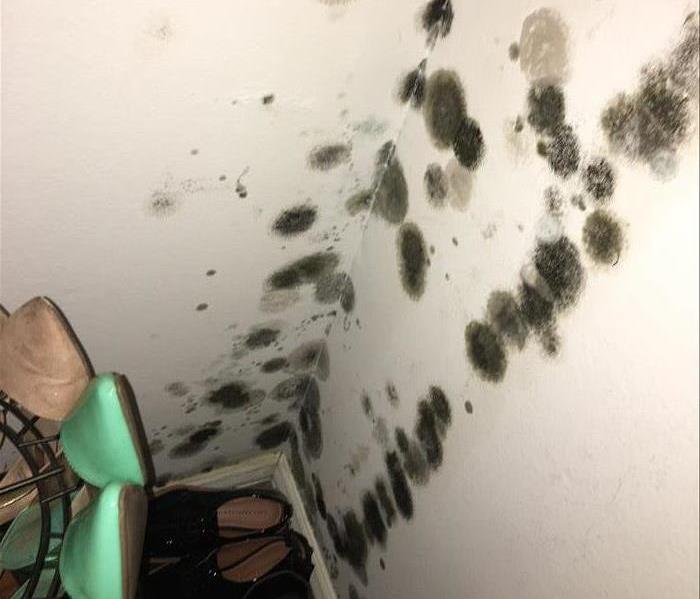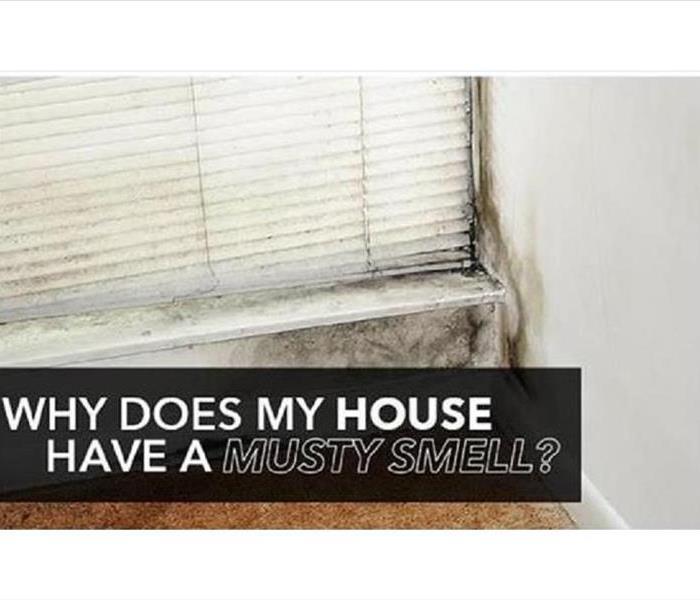Recent Mold Remediation Posts
When To Know If Your Renters Insurance Covers Mold Or Not?
8/5/2021 (Permalink)
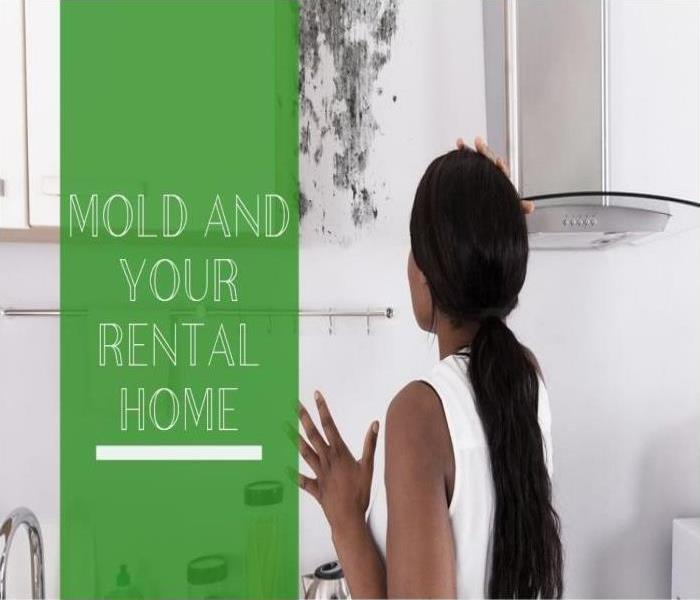 Does renters insurance cover mildew damage or mold remediation?
Does renters insurance cover mildew damage or mold remediation?
When getting renters insurance for the first time, there was so much about it I didn’t know, especially mildew and mold coverage. Most people only think about a break in, water damage or fire. What do you do if you find mold? Is that covered? Instead of asking whether or not rental insurance covers mold damage, you should consider rephrasing the question to "Does renters' insurance cover mildew damage or mold remediation?" Phrased like this, you have a better idea of what to look for when perusing your renters' insurance policy. During your review, you should look for the following items:
- Exclusions
- Duty to mitigate
- Mold caused by a covered peril
Within each of these sections, you should find information regarding what type of damage is and is not covered.
Exclusions
Typically, the limits on mildew damage in a rental insurance policy are relatively low, at right around $5,000. This should be enough to cover the cost of damage. If the damage is more than $5,000, the insurance company might assume that the damage was present for a while and that you failed to mitigate it in time.
Duty To Mitigate
If the mold was present before you moved in, or if it’s a result of an inherent defect with the property, then mold removal is likely the landlord's responsibility. However, if the damage was caused by a covered peril, and if it could have been stopped from spreading, the insurance company may only cover it up to the point where you should have known about it. For instance, if the damage was caused by a leaky pipe, and if you knew about the leaky pipe but failed to inform your landlord of it so he or she could make the repair, damage caused to your belongings may not be covered.
Mold Caused by a Covered Peril
If the mold damage was caused by, say, the water from a hose used to put out a fire, and if fire is covered under your policy, then the damage should be covered by your policy. However, you likely must prove that you made a good faith effort to prevent the damage from becoming worse.
If you discover mold on your rental property, reach out to the mold remediation experts at SERVPRO Of East Riverside City to discuss remediation options. The experts can also help you examine your rental insurance policy and determine whether or not the damage is covered.
Personal Protective Equipment (PPE) for Mold
7/22/2021 (Permalink)
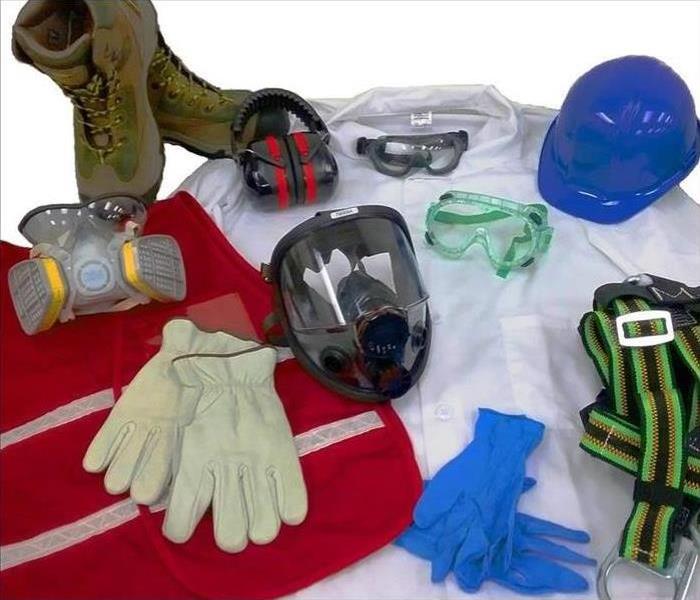 Personal Protective Equipment (PPE) for Mold
Personal Protective Equipment (PPE) for Mold
Any remediation work that disturbs mold and causes mold spores to become airborne increases the degree of respiratory exposure. Actions that tend to disperse mold include: breaking apart moldy porous materials such as wallboard; destructive invasive procedures to examine or remediate mold growth in a wall cavity; removal of contaminated wallpaper by stripping or peeling; using fans to dry items or ventilate areas.
The primary function of personal protective equipment is to prevent the inhalation and ingestion of mold and mold spores and to avoid mold contact with the skin or eyes. The following sections discuss the various types of PPE that may be used during remediation activities.
Skin and Eye Protection
Gloves protect the skin from contact with mold, as well as from potentially irritating cleaning solutions. Long gloves that extend to the middle of the forearm are recommended. The glove material should be selected based on the type of substance/ chemical being handled. If you are using a biocide such as chlorine bleach, or a strong cleaning solution, you should select gloves made from natural rubber, neoprene, nitrile, polyurethane, or PVC. If you are using a mild detergent or plain water, ordinary household rubber gloves may be used.
To protect your eyes, use properly fitted goggles or a full face piece respirator. Goggles must be designed to prevent the entry of dust and small particles. Safety glasses or goggles with open vent holes are not appropriate in mold remediation.
Respiratory Protection
Respirators protect cleanup workers from inhaling airborne mold, contaminated dust, and other particulates that are released during the remediation process. Either a half mask or full face piece air-purifying respirator can be used. A full face piece respirator provides both respiratory and eye protection. Please refer to the discussion of the different levels of remediation to ascertain the type of respiratory protection recommended. Respirators used to provide protection from mold and mold spores must be certified by the National Institute for Occupational Safety and Health (NIOSH). More protective respirators may have to be selected and used if toxic contaminants such as asbestos or lead are encountered during remediation.
As specified by OSHA in 29 CFR 1910.134 individuals who use respirators must be properly trained, have medical clearance, and be properly fit tested before they begin using a respirator. In addition, use of respirators requires the employer to develop and implement a written respiratory protection program, with worksite-specific procedures and elements.
Protective Clothing
While conducting building inspections and remediation work, individuals may encounter hazardous biological agents as well as chemical and physical hazards. Consequently, appropriate personal protective clothing (i.e., reusable or disposable) is recommended to minimize cross-contamination between work areas and clean areas, to prevent the transfer and spread of mold and other contaminants to street clothing, and to eliminate skin contact with mold and potential chemical exposures.
Disposable PPE should be discarded after it is used. They should be placed into impermeable bags, and usually can be discarded as ordinary construction waste. Appropriate precautions and protective equipment for biocide applicators should be selected based on the product manufacturer's warnings and recommendations (e.g., goggles or face shield, aprons or other protective clothing, gloves, and respiratory protection).
Learn more about mold and what to do until help arrives by reviewing these Mold Tips from SERVPRO Of East Riverside
Is Bleach Ok for Cleaning Mold?
7/7/2021 (Permalink)
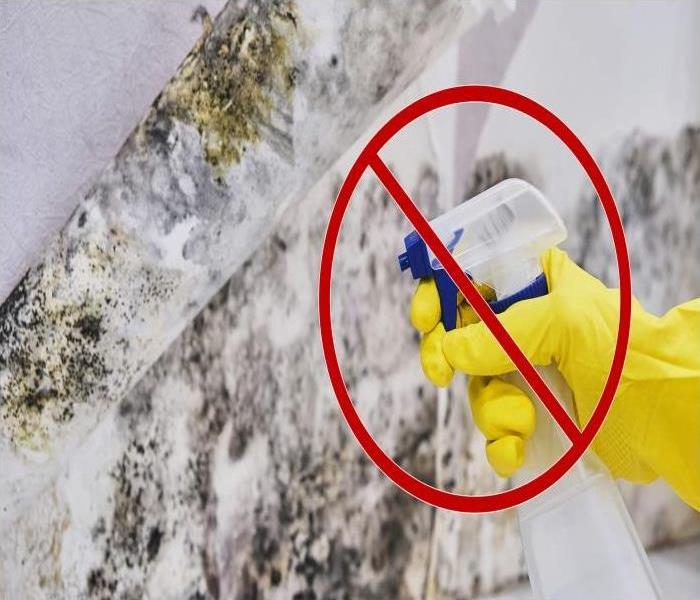 spraying bleach whenever you see mold is nothing but a myth.
spraying bleach whenever you see mold is nothing but a myth.
Did you know that bleach does not actually get rid of your mold problem? The old school thought of spraying bleach whenever you see mold is nothing but a myth. The reason people believe this works is because to the naked eye the visible mold is gone, yes, butthat is because the bleach has removed the color of mold not its roots.
When doing some research online, it came up that the OSHA (Occupational Safety and Health Administration) stopped recommending the use of bleach for dealing with mold problems. The ESA (Environmental Site Assessment) also updated their guide similarly as well.
The problem with bleach is that it is has too many variables that affect how it can treat mold. Bleach only works on killing mold on non-porous materials. Mold typically grows on porous materials like drywall and wood. So the chances your mold growth will be on a hard surface is unlikely anyways.
Using bleach to clean areas like wood can actually promote mold growth and can leave you with a bigger problem than when you originally started. This is because mold spreads its roots deep into porous surfaces. When you use bleach it creates excessive moisture which then creates a better environment for the mold to return and thrive. Bleach will also negatively affect materials like wood by breaking down its fibers. It can also cause corrosion to metals.
Bleach contains an ingredient called Sodium Hypochlorite which in high concentrations can be registered as an antimicrobial pesticide that will kill mold under the Federal Insecticide, Fungicide and Rodenticide Act. However Sodium Hypochlorite can also be sold as a household cleaner without being registered as a pesticide due to this type of item only containing small amounts of Sodium Hypochlorite. This means it is not guaranteed to kill mold nor is it sold for that purpose.
We want to steer you away from thinking bleach is the best route to dealing with your mold. Not only is it not effective but the dangerous fumes are toxic to your health. Plus, there are many anti-microbial alternatives readily available that will get the job done and are safer to use.
If you are dealing with mold in your home, it is recommended to contact a professional. Here at SERVPRO Of East Riverside we are available to answer your mold questions. Contact us today 24/7 (951)222-2224
Why You Shouldn't DIY Mold Removal
7/2/2021 (Permalink)
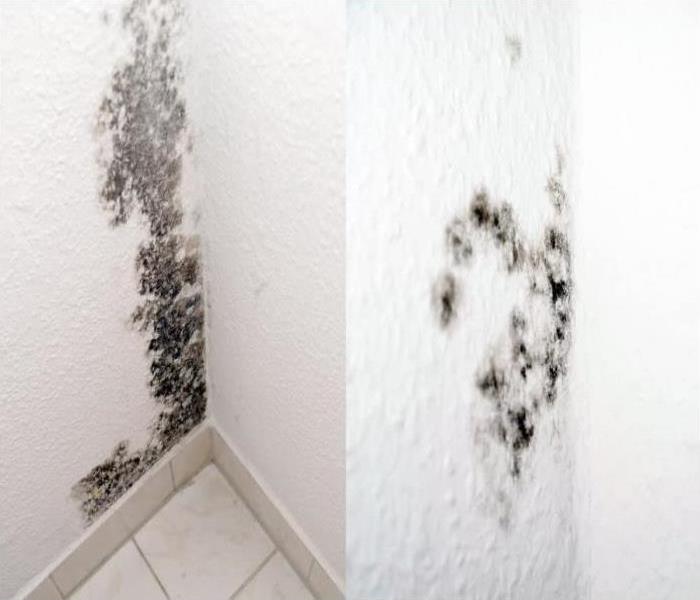 Mold Damage? No Problem
SERVPRO Of East Riverside Can Help!
Mold Damage? No Problem
SERVPRO Of East Riverside Can Help!
Why You Shouldn't DIY Mold Removal
Dry rot, mildew, and fungus are all common. Many home and business owners notice them regularly at home or at work, but does that mean they always indicate mold damage or mold growth? Mold in the home and commercial mold damage happen all the time in every part of the country. Mold is a type of fungus that needs nothing more than just a little moisture and high levels of humidity to grow rapidly and spread quickly, and that causes problems at home or work. Mold growth is nothing to take lightly, and it’s not always what it seems.
SERVPRO of East Riverside City is certified by IICRC in mold removal and remediation. IICRC is the leading expert on restoration and industry standard which all restoration is measured.
Could Mold in the Home or Commercial Mold Damage Be A Problem for Me?
Mold in the home and commercial mold damage are both entirely possible for anyone. If there is any water damage of any kind in a home or office, mold growth can occur. One of the biggest causes of mold damage in a home or office is mold growth behind the walls. It happens when water damage occurs and is not cleaned up in time for mold spores to find it and form. This can happen in a flood, it can happen when a small pipe in the walls has even a small leak, and it can happen when a pipe bursts.
This is why it’s so imperative water damage is cleaned up right away and properly. Mold growth behind walls forms quickly, and it can cause widespread damage because it’s not easily noticeable. Mold growth behind walls can cause serious mold in the home and commercial mold damage if it’s not caught in time. How do people find mold growth behind the walls and clean it up before it causes too much mold in the home or commercial mold damage? They look for the signs.
The Signs of Mold Damage
- Dry rot
- Mildew in the home
- Fungus in the home
- High levels of humidity
- Smelly odor with a musty smell
- Deodorization methods don’t work to get rid of smelly odor
Most people don’t know these are the signs of mold in the home, commercial mold damage, and even mold growth behind walls. Dry rot is a common problem in many areas of the country, and that’s confusing to home and business owners. This is not to say dry rot at home or work means there’s mold growth, too, but it can mean it’s possible. The same is true of mildew. It’s not uncommon to find mildew around faucets and around the grout in bathrooms and showers.
It certainly doesn’t mean a home or business requires mold removal, remediation, or mitigation, but it does indication conditions are right for mold growth. Mildew also needs high humidity and moisture to grow because it’s just another fungus like mold. Humidity and moisture cause mold to grow fast and spread rapidly.
If mold growth behind walls is a problem, the most common sign is a smelly odor. It’s musty and difficult to eliminate even with deodorization. It requires the use of professional remediation and mitigation as well as the proper deodorization technique a restoration company uses regularly.
Is Mold Really that Bad?
Yes. Mold is that bad because it spreads quickly. It’s not all black mold that can cause further problems that home and business owners need to worry about. Black mold is not the only mold that needs a restoration company like SERVPRO immediately. Black mold does need to be identified by a restoration company, and it certainly requires mitigation and remediation as well as mold removal services, but all mold is a problem. It takes a professional to thoroughly clean up mold damage as well as use professional deodorization to remove the smelly odor it leaves behind.
Mold removal is best handled by a restoration company like SERVPRO. Home and business owners that want to help can turn off their HVAC system to prevent spreading mold spores to other rooms in a building faster and more efficiently. They can clean up water damage immediately, and they can leave mold alone so as not to disturb the spores. Mold damage such as black mold does require professional mold removal, remediation, and mitigation, but so does all mold damage.
SERVPRO of East Riverside City is available for 24/7 emergency service. To have a crew assigned to your mold damage remediation project, give us a call at (951)222-2224
I found Mold in my house, what should I do?
7/16/2020 (Permalink)
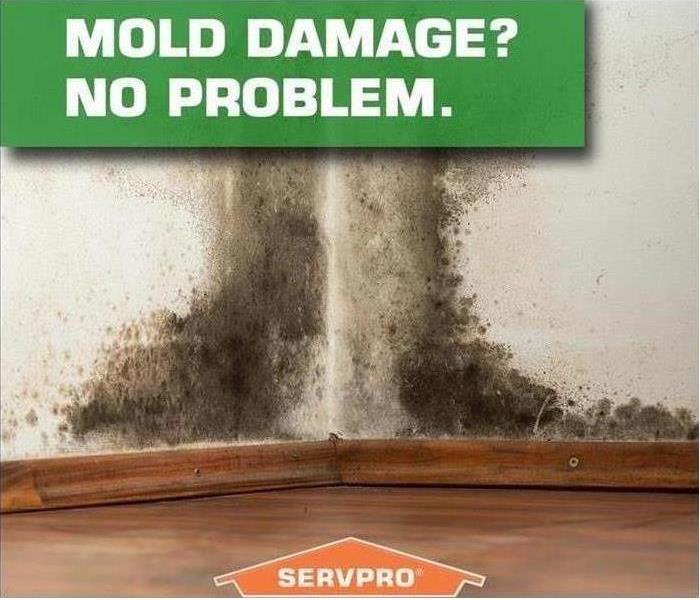 I found Mold in my house, what should I do? Don't panic - call SERVPRO of East Riverside City we are here to help 951-222-2224
I found Mold in my house, what should I do? Don't panic - call SERVPRO of East Riverside City we are here to help 951-222-2224
An old saying states that "where there is smoke, there is fire." This principal can be applied to water and mold. If you suspect that you have found mold growth in your home or office this is a tell-tell sign that there is also a water leak or unresolved water damage.
If not treated quickly, standing water inside of a structure can begin to grow mold within 24-48 hours. The EPA recommends that you begin to dry all the affected areas within this time limit to prevent any mold growth.
SERVPRO of East Riverside City has the proper equipment and training to mitigate water and mold damage. Our technicians will be at your location promptly, usually within the hour after receiving a call, to perform the proper inspections required to determine what work needs to be done. In the mean time, here are a few tips to keep in mind that can help you prevent any possible mold growth from spreading:
Do's:
- Stay out of all affected areas
- Turn off HVAC system and turn off all fans
- Contact SERVPRO of East Riverside City right away
- Call a plumber to repair the cause of the water leak
Don'ts:
- DO NOT touch or disturb areas with mold or water damage.
- DO NOT blow any air across affected surfaces
- DO NOT attempt to dry the areas yourself.
- DO NOT pour bleach on or utilize any other disinfectants onto the mold.
If you have any concerns at all, please contact the professionals at SERVPRO of East Riverside City to come and assist you in a timely manner. Their skills and training will begin the process to make it "Like it never even happened."
What should I know about Mold?
7/16/2020 (Permalink)
There are many misconceptions about mold growth, removal and especially cleanup. First thing you should know is Mold clean up is not a good time for a DIY project. Some things are best left to the professionals, mold is definitely one of them. But do not panic if you find mold in your home or office, our trained technicians are here to help sort things out for you and have the skills and equipment to help remove it from your property.
Who Should Do the Cleanup?
Taking on the task of mold removal and cleanup can be overwhelming. If you have a small area, less than 3 square feet, you may be able to deal with it yourself. If the affected area is larger, then it is recommended you contact a trained professional with IICRC licensing for Mold Removal.
There are strict guidelines that need to be followed when it comes to mold removal so it is important to check the credentials of any company hired to ensure these guidelines are followed accurately. SERVPRO of East Riverside City is certified by IICRC in mold removal and remediation. IICRC is the leading expert on restoration and industry standard which all restoration is measured.
How To...
Mold will grow on wet surfaces, so it is important to fix any water leaks and dry-out moist areas first before focusing on the mold. If an affected area is not dried correctly the mold growth will return!
- Do not paint or apply caulking on moldy surfaces. This will only cover the problem. You must clean the mold and dry it before painting. Paint is likely to peel if the area is not properly treated.
- Absorbent or porous materials, such as ceiling tiles and carpet are recommended to be destroyed. The mold can grow or fill in the empty spaces and crevices of porous materials thus making it very difficult or impossible to remove completely.
- The use of chemical or biocides that kills organisms is not recommended. This may disinfect the area but will leave mold spores behind. Dead mold may still cause allergic reactions and may reactivate if the affected area is disturbed, or if the area on which the mold spores are living is moved or exposed. It MUST be removed.
How Do I Know the Remediation is Finished?
- There should be no visible mold or moldy odors present. Staining and cosmetic damage may remain on affected areas such as furniture or wood material. There are specialists that can restore items that cannot be replaced, although the process of restoring items like furniture or sentimental items can be expensive.
- You should be able to re-occupy the area without health complaints or physical symptoms.
If you have any further questions regarding Mold Removal feel free to contact our helpful hero's at SERVPRO East Riverside City either via email info@servpoer.com or directly at #951-222-2224.
Avoid Mold by Controlling Moisture
5/11/2020 (Permalink)
Moisture levels within a home can elevate the risk for mold growth. Whether the water comes from a leak, high humidity or the varying temperatures that can be found in different areas of the house, your best solution is to reduce these moisture levels as much as possible. If things are not taken care of in a timely manner then it could spell disaster for those in your household who suffer from allergies, asthma or other health related issues. SERVPRO of East Riverside City is here to help with just a few tips for you to keep in mind when dealing with any water-related issues in your home:
Dry Up All Moisture You Find
Unfortunately, even the smallest water leaks can turn into a major mold problem if they are not dealt with immediately. Make sure to check the pipes under all of your sinks for a leak. It is also good to check the water lines that connect the washing machines and refrigerators to the wall. Any leaks should be fixed right away.
Also keep in mind that water can spill from a pot when watering an indoor plant. Make sure to add a dish underneath any pots containing plants in case of a leak. It is also advisable to never leave a plant pot on a carpet, rug or other household item that contains fabric. These fabrics can be perfect for mold growth if moisture seeps into them.
Monitor Hot-Water Heater & Moisture Levels of Below Ground Areas
Monitoring your hot-water heater and the area around it on a regular basis can save you from a major headache in the event of a leak. One way that this can be done is with a floor-water alarm that can be purchased and installed near your hot-water heater or can be tied in with your home's central alarm system if it has one.
Make sure to monitor areas that are below ground, such as basements and crawl spaces, for their relative humidity (RH). Not all mold growth requires standing water so use a thermo-hygrometer to measure the RH of these areas. You want the RH to be between 50-60%. It may also be a good idea to buy a dehumidifier for the less-dry months. This can help prevent mold growth and keep the RH at a consistent and safe level.
Keep Warm While Controlling Humidity
Don't allow humidity levels to climb for any above-ground areas. This can be especially true during the colder months when windows are less likely to be opened. Turning on the exhaust fan above a cooking area can help mitigate RH levels. After showering or bathing, make sure to use the exhaust fan to draw out the moisture in the air. Leaving the bathroom door open afterwards can also reduce RH levels.
Make sure to also keep any closets that have walls facing the exterior of a structure warm. These walls can develop mold growth. Also, make sure not to over stuff your closet with personal goods as this can prevent the heat from penetrating into the closet. Also make sure that the closet does not contain any carpeting as carpet can capture biodegradable dust and matter which can further encourage mold growth.
Keep All Rooms Warm During Winter
Though Southern California only experiences a brief time where it is cold, it is still advisable to keep all of the rooms at a comfortably warm temperature. Yes, it may make economical sense to only heat those rooms that are in use more often, but with colder temperatures comes higher RH levels even for those rooms that are above ground! This can lead to serious mold growth so keep your house warm.
Isolate Crawl Spaces & Monitor Moisture Levels in Attached Garages
Any crawl space should be isolated from the outside and should regularly be dehumidified. If your home contains a crawl space then it should be covered with a mesh-reinforced vapor barrier or even be completely cemented over. This will limit the evaporation from the underlying soil.
The moisture levels within an attached garage should also be closely monitored. Make sure not to introduce any unnecessary moisture. Though rare for Southern California, monitoring should be done especially for humid or inclement weather as the RH levels can rise. Keeping these levels of an attached garage under 70% should be sufficient.
These are only a few tips to help you keep your house safe from mold growth and should only be applied to small amounts of water. If your home experiences a major water loss, such as burst pipes, toilet or dishwasher overflow or any other major water source then make sure to give SERVPRO of East Riverside City a call. We will help navigate you through any of your major water loss needs!
Take control of the Mold around you
5/7/2020 (Permalink)
A growing concern for homeowners and renters is the possibility of mold. It’s a valid concern as mold can pose real health hazards. This concern is especially valid with schools and commercial buildings which tend to have a high volume of foot traffic as well as occupants of varying ages and degrees of health. Being pro-active is the key to overcoming this concern.
It is important to come to terms with the fact that mold is everywhere. There is no such thing as a "mold-free building". Mold spores cannot be seen with the naked eye. They can become air born with even the slightest of movements and can attach themselves to any surface and begin to grow.
What’s the best way to control mold?
Here are 3 easy steps you can implement right away:
1. Have good Ventilation
2. Repair water leaks ASAP
3. Act Quickly; dry wet areas within 48 hours
If you’re concerned that your home, apartment or office space may have mold, call the Mold Remediation experts at SERVPRO of East Riverside to take a look. The EPR has great information on mold in commercial buildings and school campuses.
Truth About Mold
5/6/2020 (Permalink)
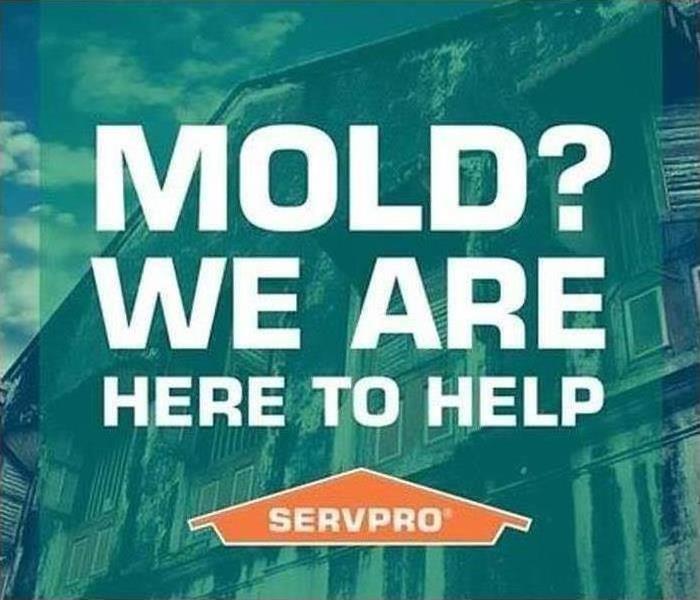 SERVPRO of East Riverside City is IICRC certified to properly remove mold from your office or home.
SERVPRO of East Riverside City is IICRC certified to properly remove mold from your office or home.
Mold can be a scary word, but the truth is: not all mold is bad. In fact, people can find certain types of mold quite enjoyable. Blue cheese is a result of mold. Edible mushrooms are a type of fungi. Even the antibiotic Penicillin is a product of mold. However, certain forms of mold can be harmful and may cause health effects for some people.
Those at Risk:
- Infants and children
- Pregnant Women
- The Elderly
- People with compromised respiratory systems or asthma and allergies
- People with weakened immune systems
Where Does Mold Come From?
Mold is all around us. Some levels of mold in your home are common and normal. Mold becomes a problem when it becomes excessive. Certain conditions feed the normal levels of mold causing the mold to grow.
1- If you have a water leak or flood in your home, big or small, it needs to be addressed promptly and professionally to prevent harmful mold growth.
2- If the humidity and moisture levels are not properly monitored this creates an environment for mold spores to grow and multiply.
3- If water leaks are not addressed at the source any mold can return or even spread.
What Can You Do?
Be alert for moister problems in your home or office. Fix leaks or plumbing issues promptly. A strong, musty odor can be a sign of mold that may not to visible. If you suspect harmful mold, call the professionals.
Do not try to remove the mold yourself. True not all types of mold are bad but it's best to leave any clean up to the professionals rather than risk getting you or your family ill. If not removed properly, you risk spreading the mold spores.
Do not treat the area with bleach. This may treat the surface but may mask the mold growing under the surface or within the walls and other surrounding material. Giving it a chance to continue growing and spreading.
Do not turn on your HVAC or use fans or air blower in the area with suspected mold. This will spread the mold spores to the rest of your home or office.
If you're unsure about the mold in your home or office call the professionals at SERVPRO of East Riverside City who are trained in mold remediation and can assist and advise you if further testing is required. Our team is IICRC certified and ready to make it "Like it never even happened."
Why does Mold grow?
5/4/2020 (Permalink)
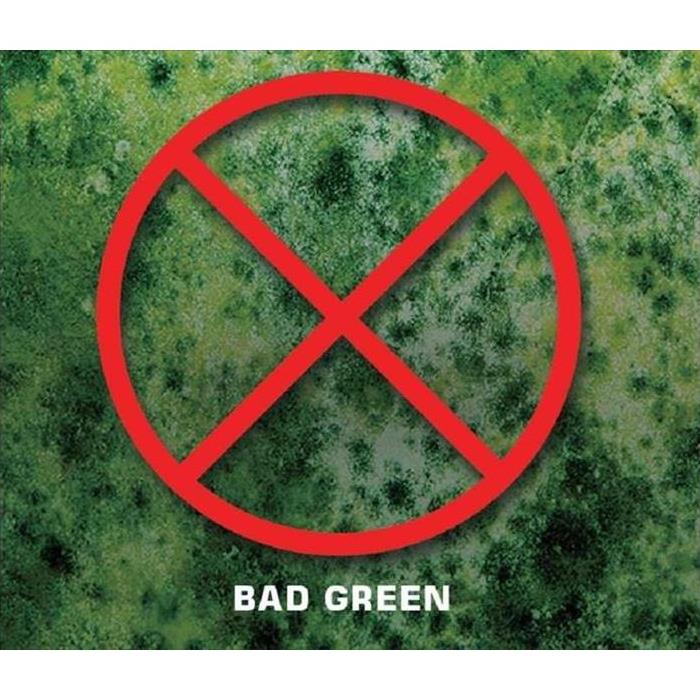 If mold is a problem in your home, promptly fix the water problem and contact the professionals like SERVPRO of East Riverside City
If mold is a problem in your home, promptly fix the water problem and contact the professionals like SERVPRO of East Riverside City
Mold and mold spores are a natural part of our environment, both indoors and outside. Outside mold plays an important role in breaking down dead organic matter such as fallen leaves and dead trees. However, indoor mold growth should be avoided. Mold spores cannot be seen by the naked eye and float through the air, traveling throughout our environment. Mold begins to grow when the spores land on a wet surface. There are many different types of mold and they cannot grow without moisture.
Effects of Mold
Mold gradually destroys things that it grows on. The research of the effect of mold on a person's health is ongoing. For information on health concerns, consult your health care professional or your local health department.
What Can You Do?
Because mold spores are everywhere it is impossible to eliminate spores completely. The best way to control mold growth is to control moisture. If you see mold growing in your home then you can be certain that you have a water leak or a moisture problem. The source of the water or moisture needs to be addressed along with the removal of the mold itself. If you clean the mold and do not fix the source, the mold problem will return.
Main Points
- The key to mold control is moisture control.
- If mold is a problem in your home, promptly fix the water problem and contact the professionals like SERVPRO of East Riverside City to remove the mold safety.
- It is important to dry water damaged areas within 24-48 hours to prevent mold growth.
- If ever in doubt call our team of hero's, we are here to help.
Could it be something More?
4/1/2020 (Permalink)
Most of the population can identify the fuzzy growth on their bread or dark patches under the kitchen sink as mold. Before you attempt to remove that patch yourself it is important to identify what it is first.
Disturbing mold can release into the air thousands, if not millions of spores! Which may plant themselves and start to grown elsewhere or end up in the lungs of any one nearby. Knowing whether or not the mold growing is toxic or not is truly beneficial.
Once you know what you are dealing with you can take the needed precautions to protect yourself and the rest of your home. This is why the professionals at SERVPRO of East Riverside City not only "suit-up" but will set up containment around the affected area to prevent these spores from spreading.
How To Test
It is highly recognized that both surface and air sampling is done to get an accurate evaluation of both the indoor air quality and the specific mold type.
This is done through first a visual inspection; looking at microbial activity, water stains, moisture intrusion and musty odors from room to room. Checking suspect areas with a moisture meter or thermal imaging camera to detect further moisture in wall cavities. Where there is moisture there is likely mold.
Then samples are taken of both the air in the room as the surface area in question either with a swab or a tape lift. These samples are then sent to a lab to be tested and identified by a third party.
So, if you suspect you have mold in your home what should you do? Don't panic, call SERVPRO of East Riverside City and we can help you through the process.
What is that smell?
4/1/2020 (Permalink)
What’s that smell?” A wife asks her husband after returning from a long day of work. “Did you leave wet clothes out again?” she says as she checks the bathroom and hamper where the odor seems to be emanating from. The thought comes to her mind: could it be mold? If you’ve experienced this scenario in the past, here are some places you may want to check.
Dishwasher
There are two connections under each dishwasher that have the potential for mold and mildew growth. 1st the water supply line and 2nd the discharge hose. The Water Supply line needs to be lubricated and properly tightened periodically. The discharge hose involves a hose made of rubber and a clamp. The hose can wear out over time and the clamp can loosen. Check these if your dishwasher is over three years old or you notice an odd smell when opening the door.
Ice Maker
Moving a fridge can weaken or break the water line connection to the ice maker causing leaks behind the fridge. Check the connection periodically to ensure that no leak has formed.
Washing Machine
Remember, even the smallest amount of water creates the perfect environment for mold growth. All rubber washers need to be tight to prevent leaks. Also, regularly check any hose that supplies or drains water from the washing machine for cracks or leaks.
Hot Water Heater
Most states have laws requiring overflow pans to be installed so that the water is drained outside. Check that your water heater is properly installed. If your home contains an older model water heater, make sure that an overflow pan has been properly added to decrease chances of mold growth.
P-Traps
Under every sink in your home is a “P-Trap” which prevents sewer gases from entering inside. They are often made out of PVC, which has a tendency to expand and contract while in use. This causes the P-Trap connection to eventually loosen over time, allowing water to leak onto the base of the cabinet. Use Teflon tape to seal the P-Trap and check them periodically. Take care to not over tighten the PVC pipe which can cause it to crack.
Toilet Connections
The most common place on a toilet where mold growth can be found is at its base. The grout around the base serves as a filter between the bowl and floor to keep it from rocking, thus preventing the the wax ring from being compromised and allowing mold to grow.
Shower Door
Mold growth at the base of the tub may be from a leaking or improperly installed shower door. The door needs caulking on all three rails--the two side rails and the bottom rail--to ensure water does not leak out.
Tub
Cracks in the caulking allows for water to drip down underneath the tub, causing mold growth. If you have a slab floor, there is an even greater risk for mold growth as holes in the concrete will hold onto moisture and can allow moisture to come from the bottom up. These areas can be filled with liquid tar or expandable foam to seal them.
Exterior Hose Base
A poor connection, missing rubber washer or loose hose can result in water spraying out. This can cause the water to enter cracks or other inaccessible areas where mold can grow. Make sure all holes, gaps or areas around every outdoor water connection have been properly caulked and sealed.
Outdoor Sprinklers
Keep sprinklers away from the house and make sure they spray away from any structure. Also remind children or teens that they may water the garden or use sprinklers to play in, but not to spray the house directly.
By taking proper precautions and being vigilant with upkeep, you can avoid mold growth or catch it before it spreads. If you do suspect mold in your home or office call SERVPRO of East Riverside City for a courtesy inspection.

 24/7 Emergency Service
24/7 Emergency Service







